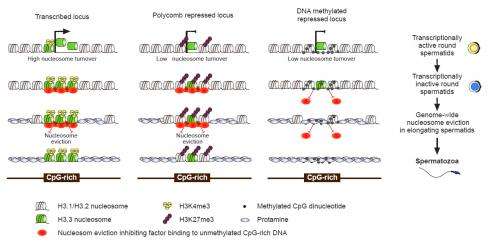Setting the stage for passing on epigenetic information to the next generation

(Phys.org) —In a comprehensive study, scientists at the Friedrich Miescher Institute for Biomedical Research identified the molecular logic underlying the retention of histones and their marks during the development of the sperm. These findings set the stage to address a fundamental question in epigenetics: whether and how chromatin marks in sperm are passed on to the next generation and contribute the epigenetic inheritance of traits shaped by experience or the environment. Their results were recently published online in Nature Structural & Molecular Biology.
The saying "like father, like son" tells the truth to a degree that goes beyond what many of us grasp. Did you know that if a man overeats in the years before puberty, this has a direct influence on the health of his future sons and grandsons? The Överkalix study, conducted in a remote village in Sweden, reaches exactly this conclusion: these sons and grandsons—but not the daughters and granddaughters—die more often from diabetes or cardiovascular diseases irrespective of their own eating behavior. "Epigenetics" has been the magic term to explain this phenomenon. However, whether and how the mediators of epigenetics, modifications on DNA or histones, or changes in RNA, are passed on from one generation to the next has remained a big question mark.
Antoine Peters, group leader at the Friedrich Miescher Institute for Biomedical Research and professor at the University of Basel, describes in a study in Nature Structural & Molecular Biology how chromatin based epigenetic information is retained during the development of the sperm that eventually may be passed on to the next generation.
In sperm, DNA is 10- to 20-fold more tightly packed than in nuclei of regular cells. The tight packaging of DNA is mediated by protamine proteins, which are loaded onto the DNA during male germ cell differentiation, after histones have been removed. However, this process is not complete: about 1% of histones remain in mouse sperm, specifically at sequences with gene regulatory functions. Peters and his team determined now the logic underlying the retention of these residual histones and asked whether these histones could, in principle, play a role in the epigenetic inheritance of traits from one generation to the next.
They showed that the residing histones predominantly bind to CpG-rich DNA sequences, so called CpG-islands, but only when they are not methylated. These sequences are usually found in the promoters of genes, the stretches of DNA controlling gene expression. Peculiarly, prior to the development into mature sperm and actual nucleosome retention, these CpG-islands undergo a major remodeling of their chromatin, exchanging the replication-dependent nucleosomes containing histones H3.1 and H3.2 for nucleosomes containing the histone variant H3.3. The level of exchange correlates with CpG-richness and the level of transcription of genes controlled by the CpG-islands. There are, however, some exceptions. The scientists could show that the level of nucleosomal exchange is low at "repressed" CpG-islands that harbor nucleosomes marked by tri-methylation of lysine 27 on histone H3 (H3K27me3), which is catalyzed by Polycomb Group Proteins. Interestingly, such CpG islands retain the "old" H3.1/H3.2 histones in sperm. Furthermore, the scientists could then show that most genes controlled by promoters that retain H3.1/H3.2 are repressed in the early embryo as in the male germ line.
"With this comprehensive study of the mechanisms controlling the retention of histones during sperm cell development, we have been able to identify a promising candidate for epigenetic inheritance between generations in the mouse model system," comments Peters. "Since we could further show that the basic principles are evolutionarily conserved between mouse and men, we believe this is the first step towards a better molecular understanding of epigenetic inheritance of traits shaped by experience or the environment, such as the observations in the Överkalix community."
More information: Erkek, S. et al. (2013) Molecular determinants of nucleosome retention at CpG-rich sequences in mouse spermatozoa. Nat Struct Mol Biol. doi:10.1038/nsmb.2599
Journal information: Nature Structural & Molecular Biology


















